-
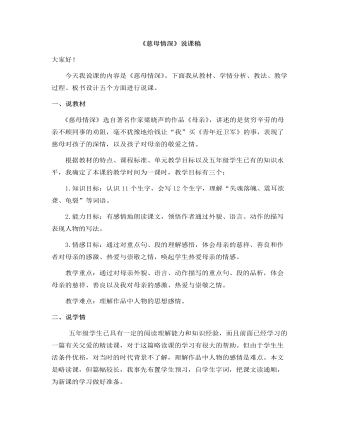
部编人教版五年级上册《慈母情深》说课稿
大家好!今天我说课的内容是《慈母情深》。下面我从教材、学情分析、教法、教学过程、板书设计五个方面进行说课。一、说教材《慈母情深》选自著名作家梁晓声的作品《母亲》,讲述的是贫穷辛劳的母亲不顾同事的劝阻,毫不犹豫地给钱让“我”买《青年近卫军》的事,表现了慈母对孩子的深情,以及孩子对母亲的敬爱之情。根据教材的特点、课程标准、单元教学目标以及五年级学生已有的知识水平,我确定了本课的教学时间为一课时,教学目标有三个:1.知识目标:认识11个生字,会写12个生字,理解“失魂落魄、震耳欲聋、龟裂”等词语。
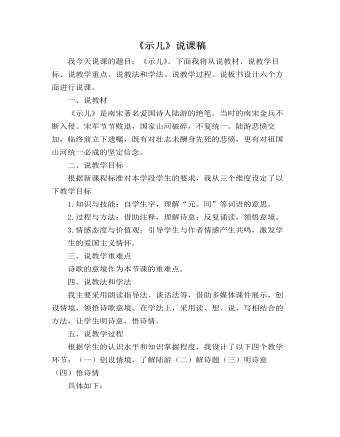
部编人教版五年级上册《古诗三首-示儿》说课稿
一、说教材《示儿》是南宋著名爱国诗人陆游的绝笔。当时的南宋金兵不断入侵、宋军节节败退,国家山河破碎,不复统一。陆游悲愤交加,临终前立下遗嘱,既有对壮志未酬身先死的悲愤,更有对祖国山河统一必成的坚定信念。二、说教学目标根据新课程标准对本学段学生的要求,我从三个维度设定了以下教学目标1.知识与技能:自学生字,理解“元、同”等词语的意思。2.过程与方法:借助注释,理解诗意;反复诵读,领悟意境。3.情感态度与价值观:引导学生与作者情感产生共鸣,激发学生的爱国主义情怀。三、说教学重难点诗歌的意境作为本节课的重难点。四、说教法和学法我主要采用朗读指导法、谈话法等,借助多媒体课件展示,创设情境,领悟诗歌意境。在学法上,采用读、想、说、写相结合的方法,让学生明诗意、悟诗情。

部编人教版五年级上册《古诗三首-题临安邸》说课稿
其次,教学目标的设定。1.学会本诗中的生字,能正确、流利、有感情朗读古诗,借助教材注释,正确理解古诗的大概意思。2.理解诗人所要表达的思想感情,让学生从中受到教育。3.通过反复诵读,在读中感悟,体会诗歌中表达的思想感情。最后,教学重点、难点的确定。我将教学重点设为有感情地朗读古诗,正确理解古诗大意,体会诗人忧国忧民的情怀。教学难点是在领悟想象中感受诗歌的意象,体会诗人抒发的情感。二、说教法按照语文新课程标准的要求,结合小学生的特点,在教学时我主要采用以下教学方法。1.朗读法,让学生品味诗句的韵味。2.情境教学法。创设情境,利用图片等,激发学生的好奇心和求知欲望。3.启发式教学法,合理设置问题,引导学生把握知识点。
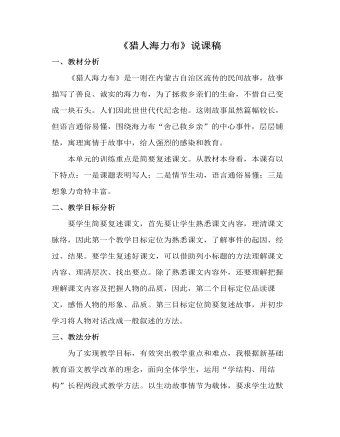
部编人教版五年级上册《猎人海力布》说课稿
一、教材分析《猎人海力布》是一则在内蒙古自治区流传的民间故事,故事描写了善良、诚实的海力布,为了拯救乡亲们的生命,不惜自己变成一块石头。人们因此世世代代纪念他。这则故事虽然篇幅较长,但语言通俗易懂,围绕海力布“舍己救乡亲”的中心事件,层层铺垫,寓理寓情于故事中,给人强烈的感染和教育。本单元的训练重点是简要复述课文。从教材本身看,本课有以下特点:一是课题表明写人;二是情节生动,语言通俗易懂;三是想象力奇特丰富。二、教学目标分析要学生简要复述课文,首先要让学生熟悉课文内容,理清课文脉络,因此第一个教学目标定位为熟悉课文,了解事件的起因、经过、结果。要学生复述好课文,可以借助列小标题的方法理解课文内容、理清层次、找出要点。除了熟悉课文内容外,还要理解把握理解课文内容及把握人物的品质,因此,第二个目标定位品读课文,感悟人物的形象、品质。第三目标定位简要复述故事,并初步学习将人物对话改成一般叙述的方法。
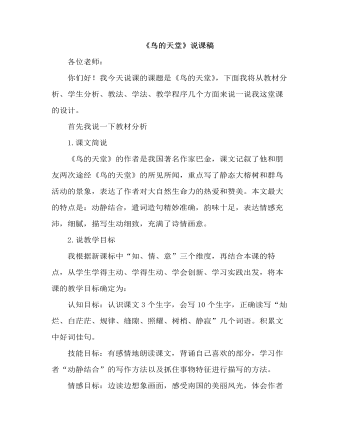
部编人教版五年级上册《鸟的天堂》说课稿
二、学生分析五年级是小学生知识、能力、情感价值观形成的关键时期,他们对自我、他人、家庭、社会有了一些浅显的认识,养成了一定的好的学习习惯,有了一定的阅读能力,读书提问的能力。因本课的阅读性、活动性、实践性较强,绝大部分学生对于如何在阅读活动中边读边想的方法不明确,在实践中应怎想,想什么不够明晰。下面为了讲清重点、难点,使学生能达到本节设定的教学目标,我再从教法和学法上谈谈。三、说教法在教学中,我们不仅要让学生“知其然”而且要让学生“知其所以然”,科学合理的教学方法,能使教学效果事半功倍,达到教与学的和谐完美统一。为了达到目标,突出重点,突破难点,解决疑难,我具体运用了以下几种教法,情景设置法——主要是激发学生情感,引起他们的学习兴趣,讲授法——充分发挥教师的主导作用,系统地向学生传授知识。点拨法——是教师在学生讨论的过程中,伺机点拨,让他们展开联想和想象,拓展思路。在以上几种教法中点拨法是最重要的一种方法。
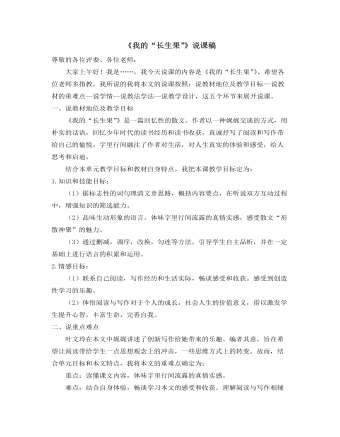
部编人教版五年级上册《我的“长生果”》说课稿
尊敬的各位评委、各位老师:大家上午好!我是……,我今天说课的内容是《我的“长生果”》。希望各位老师多指教。我所说的我将本文的说课按照:说教材地位及教学目标--说教材的重难点--说学情--说教法学法--说教学设计,这五个环节来展开说课。一、说教材地位及教学目标《我的“长生果”》是一篇回忆性的散文。作者以一种娓娓交谈的方式,用朴实的话语,回忆少年时代的读书经历和读书收获,真诚抒写了阅读和写作带给自己的愉悦。字里行间融注了作者对生活,对人生真实的体验和感受,给人思考和启迪。结合本单元教学目标和教材自身特点,我把本课教学目标定为:1.知识和技能目标:(1)据标志性的词句理清文章思路,概括内容要点,在听说双方互动过程中,增强知识的筛选能力。(2)品味生动形象的语言,体味字里行间流露的真情实感,感受散文“形散神聚”的魅力。

部编人教版五年级下册《 红楼春趣》说课稿
三、说学情:五年级学生对于《红楼梦》比较陌生,课文又是节选自原文,文中的很多语言艰涩难懂,甚至连读通都不容易;而且学生所掌握的《红楼梦》的背景知识和关于《红楼梦》的生活体验几乎为零,理解更为不易。因此,在教学中要致力于指导学生读通课文,通过课文中的相关描写了解课文描写的场景,感受课文中的人物形象。引导学生学习作者抓住人物的语言、动作、神态等描写人物的方法。四、说教法和学法:新课程标准中指出,学生是学习的主体,而教师则是教学活动的组织者和引导者。“阅读是学生个性化的行为,不应以教师的分析来取代学生的阅读。”所以,本课时的教学,主要是学生的自读感悟和教师的引导并举,突出学生的自读感悟,引导学生通过细节感悟语言文字。在本课教学中,让学生自己去感受人物的形象,在感悟的同时,也体会作家描写人物的方法,重点体会语言、肖像描写。五、教具准备:多媒体课件
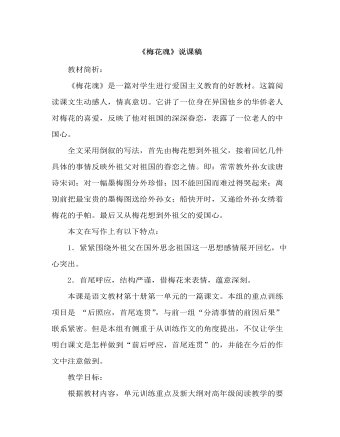
部编人教版五年级下册《 梅花魂》说课稿
全文采用倒叙的写法,首先由梅花想到外祖父,接着回忆几件具体的事情反映外祖父对祖国的眷恋之情。即:常常教外孙女读唐诗宋词;对一幅墨梅图分外珍惜;因不能回国而难过得哭起来;离别前把最宝贵的墨梅图送给外孙女;船快开时,又递给外孙女绣着梅花的手帕。最后又从梅花想到外祖父的爱国心。本文在写作上有以下特点:1.紧紧围绕外祖父在国外思念祖国这一思想感情展开回忆,中心突出。2.首尾呼应,结构严谨,借梅花来表情,蕴意深刻。本课是语文教材第十册第一单元的一篇课文。本组的重点训练项目是 “后照应,首尾连贯”,与前一组“分清事情的前因后果”联系紧密。但是本组有侧重于从训练作文的角度提出,不仅让学生明白课文是怎样做到“前后呼应,首尾连贯”的,并能在今后的作文中注意做到。
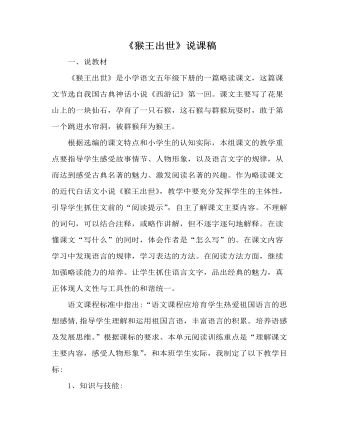
部编人教版五年级下册《猴王出世》说课稿
一、说教材《猴王出世》是小学语文五年级下册的一篇略读课文,这篇课文节选自我国古典神话小说《西游记》第一回。课文主要写了花果山上的一块仙石,孕育了一只石猴,这石猴与群猴玩耍时,敢于第一个跳进水帘洞,被群猴拜为猴王。根据选编的课文特点和小学生的认知实际,本组课文的教学重点要指导学生感受故事情节、人物形象,以及语言文字的规律,从而达到感受古典名著的魅力、激发阅读名著的兴趣。作为略读课文的近代白话文小说《猴王出世》,教学中要充分发挥学生的主体性,引导学生抓住文前的“阅读提示”,自主了解课文主要内容。不理解的词句,可以结合注释,或略作讲解,但不逐字逐句地解释。在读懂课文“写什么”的同时,体会作者是“怎么写”的。在课文内容学习中发现语言的规律,学习表达的方法。在阅读方法方面,继续加强略读能力的培养。让学生抓住语言文字,品出经典的魅力,真正体现人文性与工具性的和谐统一。

部编人教版五年级下册《金字塔》说课稿
二、说教学目标及重难点:1.教学目标 :(1)自主学习文中的“译、愧”等12个生字,读准字音,理解字义。(2)指导学生读课文,读准字音,读通句子,理清文章脉络。(3)正确、流利、有感情地朗读课文,了解课文主要内容,初步体会金字塔的雄伟与神秘,从本课语言文字材料中感受古埃及人民的勤劳和智慧。(4)了解两篇课文介绍金字塔的不同方式,发现两篇课文中相互印证的内容。(5)搜集资料,用自己喜欢的方式介绍金字塔。3.教学难点:了解课文主要内容,初步体会金字塔的雄伟与神秘,感受古埃及人民的勤劳和智慧;了解两篇课文介绍金字塔的不同方式,发现两篇课文相互印证的内容三、说学情:小学生对金字塔比较陌生,对金字塔的有关资料了解很少,针对这一情况,教学前,引导学生搜集与金字塔有关的图文资料,目的是通过阅读资料和欣赏图片激发学生强烈的学习欲望,激发学生主动探究的学习精神。
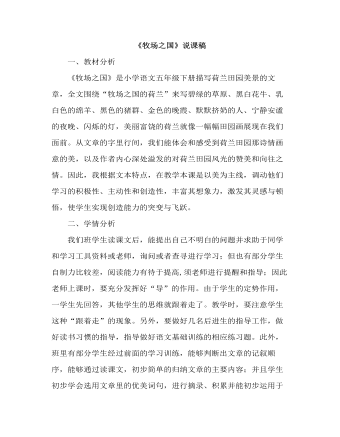
部编人教版五年级下册《牧场之国》说课稿
一、教材分析《牧场之国》是小学语文五年级下册描写荷兰田园美景的文章,全文围绕“牧场之国的荷兰”来写碧绿的草原、黑白花牛、乳白色的绵羊、黑色的猪群、金色的晚霞、默默挤奶的人、宁静安谧的夜晚、闪烁的灯,美丽富饶的荷兰就像一幅幅田园画展现在我们面前。从文章的字里行间,我们能体会和感受到荷兰田园那诗情画意的美,以及作者内心深处溢发的对荷兰田园风光的赞美和向往之情。因此,我根据文本特点,在教学本课是以美为主线,调动他们学习的积极性、主动性和创造性,丰富其想象力,激发其灵感与顿悟,使学生实现创造能力的突变与飞跃。三、目标设计依据四年级儿童特点和教材特色,本着“学语文、用语文”的课研精神,我把《牧场之国》的教学目标确定为:1.通过正确、流利地朗读课文,了解荷兰牧场的特点,感受异国的田园风光。2.通过小组合作提高学生感悟文章语言的生动性,积累语言的能力。

部编人教版五年级下册《童年的发现》说课稿
一、本节课的设计理念: 课题中的“发现”一词是本文的文眼,教学中引导学生从课题入手提出疑问,然后进行梳理明确主要学习任务。学生自主学习,了解“我”发现了什么,重点了解“我”是怎么发现的,理清作者童年时发现胚胎发育规律的过程。二、教材分析:本课是一篇鼓励求知、鼓励大胆想象、鼓励探究发现的课文,通过作者回忆童年时发现胚胎发育规律这件趣事,反映了儿童求知若渴的心理特点和惊人的想象力。第一部分先概述了“我”九岁时发现了有关胚胎发育的规律,却在后来因此受到惩罚。第二部分具体叙述“我”发现有关胚胎发育规律的前后经过。最后,写这个发现在几年后老师讲课时得到证实,“我”情不自禁地笑出了声,结果被老师误解受到处罚,但“我”从中获得感悟。本文故事情节充满童真童趣,语言风趣幽默,并有多处内心活动的描写,真实展现了孩子内心世界。

部编人教版六年级上册《古诗三首》说课稿
二、说教学目标 1.读准多音字“曲”,会写2个生字。 2.有感情地朗读课文,背诵课文,默写《江南春》。 3.能结合注释,用自己的话说出诗句的意思,读懂诗歌大意。 4.能说出《浪淘沙》是怎样写出黄河的雄伟气势的。 5.能感悟《江南春》是抓住了哪些景物写出了江南春天的特点的。 6.结合诗句,初步感受古诗中的对偶句。 三、说教学重难点1.有感情地朗读课文,背诵课文,默写《江南春》;能理解诗歌大意,体会诗歌写法;结合诗句,初步感受古诗中的对偶句。2.能理解诗歌大意,体会诗歌写法;结合诗句,初步感受古诗中的对偶句。3.想象诗歌描绘的祖国大好河山的壮丽景色,体会诗人的情感。四、说教法学法 教学中采用“创设情境入诗境——想象画面解诗意——吟诵诗词品情感”的教学方法,注重图文结合,抓字眼、抓想象、抓吟诵。体现《语文课程标准》“以读为本”的理念,让朗读贯穿整个教学过程。在读中感受古诗优美精湛的语言文字和丰富的人文内涵,在读中引领学生入情入境,在读中有所感悟,在读中受到情感的熏陶。

部编人教版六年级上册《七律 · 长征》说课稿
一、说教材《七律·长征》是统编教材小学语文六年级上册第二单元的一篇课文,本课是毛泽东主席在1935年10月,长征即将胜利之时,回想起红军所走过的千山万水,所经历的艰难坎坷,心情激动地写下了这首诗。这首诗生动地概述了红军两万五千里长征的艰难历程,讴歌了中国工农红军在长征途中所表现出的 革命英雄主义气和革命乐观主义精神。 课标对高年级诗歌阅读提出明确要求:“阅读诗歌,大体把握诗意,想象诗歌描述的情境,体会诗人的情感。受到优秀作品的感染和激励,向往和追求美好的理想。”为此,我将本课的教学目标确定如下: 二、说教学目标: (1)知识与能力目标:能正确、流利、有感情地朗读课文,背诵课文,并学习生字,积累词语。 (2)过程与方法目标:借助多媒体课件等资源,创设情境,引领学生自主探究,互动交流,在读中理解,读中感悟。 (3)情感态度与价值观目标:体会红军大无畏的英雄气概和革命乐观主义精神。
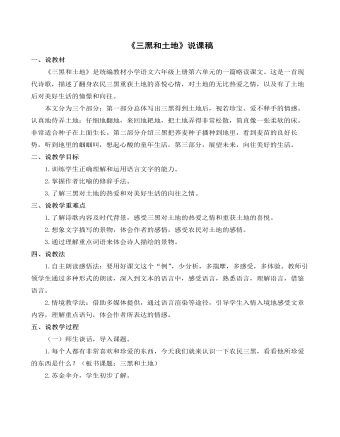
部编人教版六年级上册《三黑和土地》说课稿
一、说教材 《三黑和土地》是统编教材小学语文六年级上册第六单元的一篇略读课文。这是一首现代诗歌,描述了翻身农民三黑重获土地的喜悦心情,对土地的无比热爱之情,以及有了土地后对美好生活的憧憬和向往。 本文分为三个部分:第一部分总体写出三黑得到土地后,视若珍宝、爱不释手的情感。认真地侍弄土地:仔细地翻地,来回地耙地,把土地弄得非常松散,简直像一张柔软的床。非常适合种子在上面生长。第二部分介绍三黑把荞麦种子播种到地里,看到麦苗的良好长势,听到地里的蝈蝈叫,想起心酸的童年生活,第三部分,展望未来,向往美好的生活。 二、说教学目标 1.训练学生正确理解和运用语言文字的能力。 2.掌握作者比喻的修辞手法。 3.了解三黑对土地的热爱和对美好生活的向往之情。
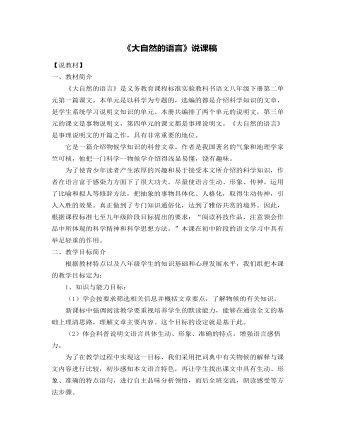
部编版语文八年级下册《大自然的语言》说课稿
二、教学目标简介根据教材特点以及八年级学生的知识基础和心理发展水平,我们组把本课的教学目标定为:1、知识与能力目标:(1)学会按要求筛选相关信息并概括文章要点,了解物候的有关知识。新课标中强调阅读教学要重视培养学生的默读能力,能够在通读全文的基础上理清思路,理解文章主要内容。这个目标的设定就是基于此。(2)体会科普说明文语言具体生动、形象、准确的特点,增强语言感悟力。为了在教学过程中实现这一目标,我们采用把词典中有关物候的解释与课文内容进行比较,初步感知本文语言特色,再让学生找出课文中具有生动、形象、准确的特点语句,进行自主品味分析领悟,而后全班交流,朗读感受等方法步骤。
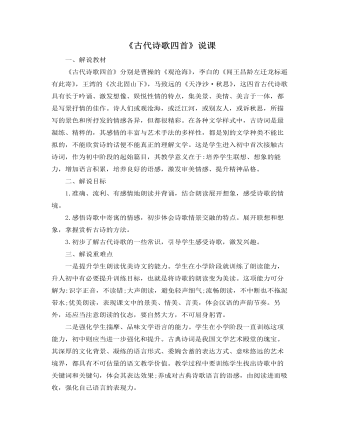
部编版语文七年级上册《古代诗歌四首》说课稿
古诗词是初中语文教学的一个难点。首先,要注重朗读,让学生通过反复朗读发现、感受古诗词的声韵之美;其次,要疏通文句,让学生准确理解诗意,感知形象,但不要求索过深,而是要避免琐碎分析,以整体感悟为主;最后要提倡背诵积累,还可以鼓励学生动手写一些评点、赏析文字。学生在小学阶段学古诗文较少,刚升人初中时要求不宜过高。要多用启发教学,避免灌输式教学;可先让学生谈感受、理解,再落实到文字。同时,做好与小学语文教学内容和教学方法的衔接也十分必要。要了解学生小学阶段的学习内容、学习方法、学习习惯等,把学习的起点放置在学生现有的语文基础上。要充分调动学生已有的文章积累、语言积累和知识积累,引导学生顺利地进人初中语文学习。例如,学生在小学学过、读过李白等人的诗歌,老师可以唤起学生的记忆,激发学生学习的兴趣;又如,学生在小学习惯于朗读,可以利用这一基础,通过朗读引导学生感受诗歌,进人诗歌的情境之中。根据教参的建议,《古代诗歌四首》课时安排为2课时。
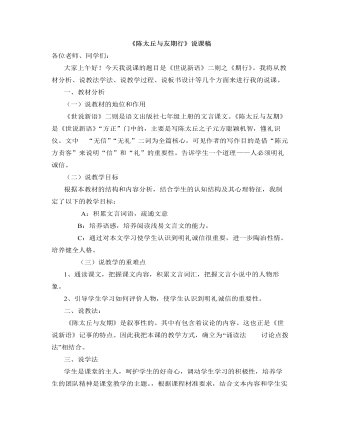
部编版语文七年级上册《陈太丘与友期行》说课稿
各位老师、同学们:大家上午好!今天我说课的题目是《世说新语》二则之《期行》。我将从教材分析、说教法学法、说教学过程、说板书设计等几个方面来进行我的说课。一、教材分析(一)说教材的地位和作用《世说新语》二则是语文出版社七年级上册的文言课文。《陈太丘与友期》是《世说新语》“方正”门中的,主要是写陈太丘之子元方聪颖机智,懂礼识仪。文中 “无信”“无礼”二词为全篇核心,可见作者的写作目的是借“陈元方责客”来说明“信”和“礼”的重要性。告诉学生一个道理——人必须明礼诚信。(二)说教学目标根据本教材的结构和内容分析,结合学生的认知结构及其心理特征,我制定了以下的教学目标:A:积累文言词语,疏通文意B:培养语感,培养阅读浅易文言文的能力。
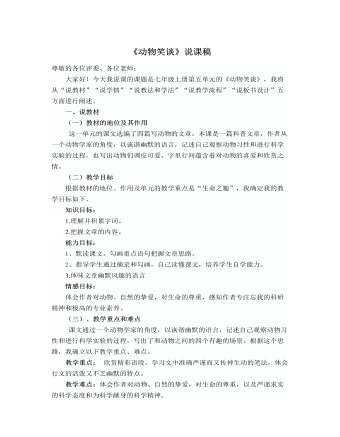
部编版语文七年级上册《动物笑谈》说课稿
(一)谈话激趣,导入新课好的开头是成功的一半,注重导入情节的创设,是兴趣激发的一个重点,也是创设学习氛围的重要环节。因此在导入新课时,我会用富有感染力的话语吸引学生,激发学生的学习兴趣。具体设计:同学们,在我们的地球上生活着大量的动物,走进它们,我们会发现世界是那么的多姿多彩,富有情趣。在这一点上,法国的法布尔做得很好,与他一样负有盛名的是奥地利的动物学家康拉德?劳伦兹,他曾经获得诺贝尔生理医学奖,今天就让我们走进他的《动物笑谈》,去看看他和动物之间有趣的故事吧!(二)初读课文,整体感知学生在预习的基础上将重点字音及成语解释在书上进行勾画和补充,进一步熟悉课文,并概括文章的主要内容。1.关于作者康拉德?劳伦兹(1903 -1989+,奥地利动物行为学家,1973年由于对动物行为学研究方面开拓性的成就而获诺贝尔生理医学奖,除了在学术上的成就之外,劳伦兹最为人所称道的是他在动物行为方面的通俗写作,著有《所罗门王的指环》《攻击的秘密》《雁语者》《狗的家世》等。
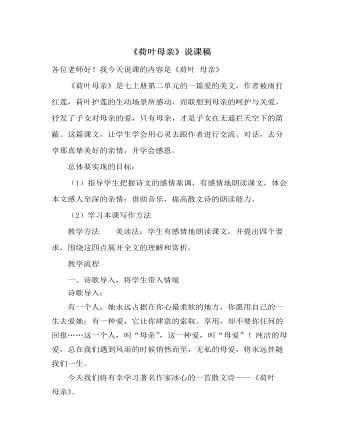
部编版语文七年级上册《荷叶·母亲》说课稿
各位老师好!我今天说课的内容是《荷叶 母亲》 《荷叶母亲》是七上册第二单元的一篇爱的美文,作者被雨打红莲,荷叶护莲的生动场景所感动,而联想到母亲的呵护与关爱,抒发了子女对母亲的爱,只有母亲,才是子女在无遮拦天空下的荫蔽。这篇课文,让学生学会用心灵去跟作者进行交流、对话,去分享那真挚美好的亲情,并学会感恩。总体要实现的目标: (1)指导学生把握诗文的感情基调,有感情地朗读课文,体会本文感人至深的亲情;借助音乐,提高散文诗的朗读能力。(2)学习本课写作方法教学方法 美读法:学生有感情地朗读课文,并提出四个要求,围绕这四点展开全文的理解和赏析。

